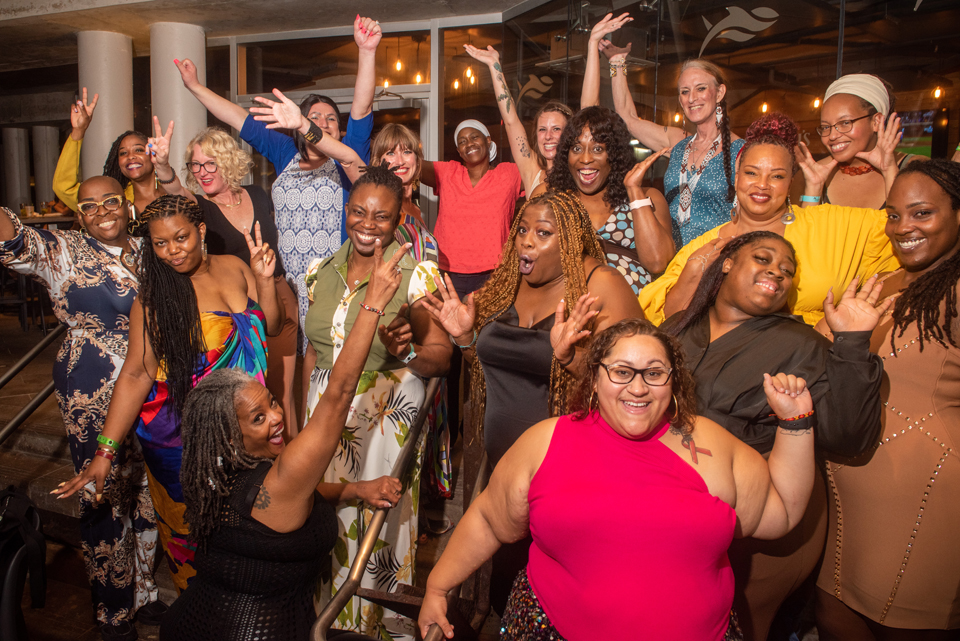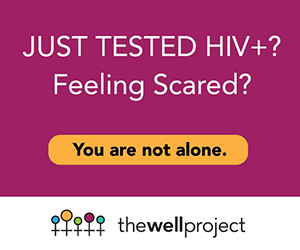
Lea esta hoja informativa en español
Table of Contents
- Who Are Lifetime Survivors of HIV?
- Treatment Experience and Challenges
- Sexual Lives and Reproductive Health
- Other HIV-Related Medical Challenges
- Women Surviving and Thriving Over a Lifetime with HIV
Who Are Lifetime Survivors of HIV?
Recent decades have seen great progress in HIV research and treatment; testing, especially of pregnant women; screening of donated blood products and organs; and the continued expansion of access to these advances worldwide. As a result, rates of HIV transmission to babies during pregnancy, birth, breast/chestfeeding, or through medical interventions have dropped significantly.
Still, there are many adults living with HIV today who acquired HIV at birth or as young children. They are lifetime survivors of HIV, meaning they have lived with HIV for their entire lives. They may have medical and other issues that are similar to older adults who have lived with HIV for many years, as well as their own unique concerns.
At the end of 2021, there were nearly 13,000 people in the US living with early acquired HIV. (That number globally is more difficult to gauge.) But there is very little information available about their lives and experiences, particularly about women.
Women lifetime survivors may face challenges stemming from their childhood, and growing into adulthood, as a person with HIV. These may include managing medication adherence (taking medicines as prescribed) at a young age and for the entirety of their lives; shifting care from pediatric to adult settings; dating, sexuality, and reproductive health; and the visible and invisible impacts of life-long medication on their bodies.
View our companion fact sheet, Lifetime Survivors of HIV, for more information about social and advocacy concerns for lifetime survivors
Treatment Experience and Challenges

"I know my HIV medication is keeping me alive. I know how important it is. I know it's working against my virus and keeping me from getting sick. But like most people I had to grow up and learn the hard way. …
"Taking my medicine was a reminder that I wasn't like everybody else–that something was wrong with me. I struggled with the acceptance of my HIV status because it came with so many different misconceptions. Subconsciously, taking my medications made feel like I wasn't normal, and it felt like an interruption to the life I was leading. It served as a reminder that I'm HIV-positive and all the negative stigma attached to it." – Porchia Dees, from "Attention Health Care Providers: Insight into Why Young People May Be Not Consistently Engaging in HIV Medical Care" on A Girl Like Me
Many lifetime survivors have been taking HIV drugs for most or all of their lives. Adolescence (roughly the time between age 10 and 19 years) is an especially rough time to have to think about taking medications of any kind. There are many reasons that may lead young people not to take their HIV drugs at the times and amounts that they were prescribed (adherence). These reasons can have to do with structural factors around systems and access; things having to do with the person themselves or their provider; things having to do with the drugs or HIV itself; or a combination of factors – and these factors change over time.
Adherence
Low adherence to HIV drugs is especially common among young people living with HIV. It is the number-one factor to consider when a person's HIV drugs stop working. There are many issues affecting adherence that are similar whether a young person is growing up in a resource-limited or resource-rich area of the world. These include concerns like:
- busy schedules filled with school and other adolescent activities
- forgetting to take your HIV drugs
- falling asleep or leaving drugs at home before a scheduled dose
Young people may stop taking HIV drugs as prescribed if they are feeling well (though it is likely that they feel well because they take HIV drugs regularly). They may also stop due to worry that others will find out they are living with HIV if they are seen taking the medications.
Some lifetime survivors have identified the relationship with their providers as an important factor in adherence.
Furthermore, after taking medications for many years, young people may simply be tired of taking them (treatment fatigue). They may also be taking a complex regimen of HIV drugs that involves a lot of pills taken at different times. When a drug is not taken correctly, it may stop working and a more difficult regimen may be needed (see the "Resistance" section below). The pills may also be too big or taste bad.
Particularly in high-resource areas of the world, having little confidence that they could adhere to their HIV drugs (self-efficacy), or not believing that HIV drugs have good effects (outcome expectancy), has been strongly linked with individuals not taking HIV drugs as prescribed. Young people may also struggle with adherence due to experiencing systemic injustices like:
- lack of medical providers or insurance
- unstable housing situations
- lack of transportation to provider appointments or to pick up HIV drugs
- concerns related to caring for family members
- other factors related to poverty
Physical factors like rapid growth and change in adolescents' bodies can affect how HIV drugs work. Uncomfortable HIV drug side effects like gut problems, headaches, or even changes in appearance (much less common with newer HIV drug regimens) may lead young people not to take their drugs.
Disclosure-related concerns also affect adherence in particular ways for young people. Those who have not been told their HIV status by caregivers may start to question why they are taking the drugs, or experience treatment fatigue. At least one study has shown that young lifetime survivors who shared their HIV status with at least one friend were less likely to hide that they were taking HIV drugs. This fact was related to higher CD4 numbers, an important marker of immune system health.
Some lifetime survivors have identified the relationship with their providers as an important factor in adherence. Provider etiquette, rapport, dialogue, and discussion about adherence can have an impact on young people's ability to take medications and attend appointments as prescribed. Young people may be at risk of lapses in care because of challenges in their relationship with the individuals or the institution from which they get care. These challenges could be with administration, appointment times, lack of ethics or empathy of staff, ineffective case managers, or the providers themselves.
It is important to remember that adherence is among the most important factors in managing HIV, especially among young people – which is why it is so vital to find the set of circumstances that works for a person to support them in taking their HIV drugs on time and as prescribed.
Click above to view or download this fact sheet as a PDF slide presentation
Drug Resistance
A key reason why HIV drug adherence is so important for staying healthy is that levels of a drug in a person’s body can drop too low when HIV drugs are not taken as prescribed, causing their virus to change and the medicine to become less effective against it (developing drug resistance). Resistance to HIV drugs can keep a person's HIV regimen from controlling HIV and reduces the options a person has for HIV drugs in the future.
Just like many long-term HIV survivors regardless of age, lifetime survivors are more likely to have drug resistance than those under 18 who were born with HIV. HIV drug regimens have gotten easier to take and have a lower risk of resistance, and those under 18 living with HIV are more likely to have been taking these newer regimens all along. When their virus is not controlled, it is more likely due to low levels of the drugs in their bodies because of low adherence, not drug resistance.
Lifetime survivors of HIV who were born earlier in the epidemic may have treatment histories as complex as those of long-term survivors who acquired HIV as adults. This often includes less modern and more toxic HIV drugs – or taking one drug (monotherapy) or two drugs by themselves, which we now know is not ideal – which play a role in their higher rates of drug resistance. They also may have been exposed to HIV treatment in the womb, increasing their chances of resistance. However, since it gets more difficult through later adolescence to keep taking HIV drugs regularly, adherence is also a factor in these situations.
HIV providers with experience caring for lifetime survivors recommend that regimens be as simple as possible (for instance, single-pill regimens). This makes taking HIV drugs more convenient, and adherence easier, for young people with so much else going on in their lives and their bodies. However, as young people get older and have taken different HIV drugs, low adherence and resulting resistance may make it hard for them to avoid more complicated regimens, continuing the cycle of adherence challenges.
Luckily, today there are more classes of HIV drugs that allow for designing powerful regimens that can be relatively easy to take and can work well even for young people with long treatment histories and drug resistance.
Transition from Pediatric to Adult Care
"Transitioning out of pediatric care was a very significant—and extremely difficult—moment in my life. Entering into adult HIV care felt cold and distant. That transition made it easy for me to fall out of care in my young adulthood. I had built such a strong bond with my pediatrician that anything less than that was hard to accept. He always talked to me about more than just my numbers—he was concerned with what was going on in my life and how I was doing with my meds. He was like a dad to me. I mean he practically took care of me my whole life. Having a provider who cares and is able to connect with you on a more personal level is important." – Porchia Dees, from "Attention Health Care Providers: Insight into Why Young People May Be Not Consistently Engaging in HIV Medical Care" on A Girl Like Me
The transition period has been shown to lead to young people falling out of HIV care, which can lead to worse health.
People between the ages of 18 and 25 transition from pediatric (child-specific) to adult care because providers have different training and institutions have different policies regarding where people of certain ages must get their care. There is a growing amount of research showing that adolescents' transition from pediatric to adult medical care settings can be a difficult process.
This is especially true for young people living with HIV, particularly those who have lived with HIV since early in life. They may have built community and friendships among the kids at their clinic – and/or a deep bond with their doctor and other members of their care team – for virtually their entire lives. These bonds may be even stronger when providers are aware of a young person's family history, which can often be painful and include the death of parents or other caregivers within their family. Young people may dread having to explain all this to a new provider. The transition period has been shown to lead to young people falling out of HIV care, which can lead to worse health.
Research and personal reflections from community members have repeatedly shown that it is critical for young people living with HIV to have providers who not only understand the complexities of HIV care and services for young people, as well as the unique needs and challenges of lifetime survivors, but who take a real, dedicated interest in the lives of young people. This includes creating a nonjudgmental, family-like environment that validates young people's experiences and feelings; and working with young people as experts in their own care and needs.
Sexual Lives and Reproductive Health

"I'm now 34 years old, healthy, unashamed, single, and in love with the woman I am. I've been loved, I've been heartbroken, I've been desired, and I've been denied. My fear of passing HIV to another has caused me to experiment with my sexuality, and my fear of being alone has caused me to tolerate domestic violence, because I thought I deserved the abuse, and I thought I couldn't do better. Through it all, I have found me. I am a strong, brave, positively beautiful Queen!" – Lynnea, from "My Cup of Tea," on A Girl Like Me
Lifetime survivors of HIV can and do nurture full and fulfilling sexual lives – and become parents to healthy, happy children if they choose to.
"Young women must be able to access HIV care with providers that are able to treat women holistically, instead of just looking at viral loads and CD4 counts. The full sexual lives of young women must be acknowledged by providers. … I have met young women born with HIV who have grown up in such fear of themselves as sexual beings that they cannot even fathom dating, much less having healthy children someday." – Grissel Granados, from "Resources and Reproductive Justice for Young Women Living with HIV" on PWN-USA's blog
While there ought to be more research to support women and their providers in this aspect of their journey, the voices of community members are clear: Lifetime survivors of HIV can and do nurture full and fulfilling sexual lives – and become parents to healthy, happy children if they choose to.
When they engage with prenatal and postpartum services, many women lifetime survivors may experience some similar challenges to women who acquired HIV later. As discussed above, the chances of a baby acquiring HIV during or soon after birth can be lower than one in 100 when the woman is taking HIV drugs that are working well. Research has shown that even women born with HIV who had drug resistance and needed to take complex HIV drug regimens to keep their virus under control during pregnancy still had HIV-negative babies and no more complications than other women living with HIV who gave birth. In the same study, almost all the women born with HIV were having their babies with partners who were not living with HIV.
Unfortunately, however, women living with HIV may still experience stigma and ignorance around their family-building choices. This often occurs when women living with HIV seek information about breastfeeding their babies. Breastfeeding while taking HIV drugs is the standard of care for women and other parents living with HIV in resource-limited areas of the world. It has been shown to increase survival and well-being of their babies, and the risk of HIV transmission with this method is extremely low. However, in high-resource settings like the US and Canada, general HIV and public health guidelines have historically discouraged breastfeeding among women living with HIV.
A significant change occurred in early 2023 with a rigorous update to the US guidelines that inform healthcare providers in their engagements specifically related to pregnancy, infant care, and HIV. The guidelines now reflect current knowledge about the extremely low (less than 1 percent) likelihood of HIV transmission through breast milk; discuss benefits of breast/chestfeeding; and encourage informed, shared infant-feeding decision-making for women and other birthing parents living with HIV. However, ending the historic stigma around breastfeeding and HIV is an ongoing effort.
Claire Gasamagera, who was born with HIV, experienced anguish and physical pain at not being able to breastfeed her sons. Adding to her frustration was the fact that, in East Africa, where she is from and where she was an activist for years, she has known numerous women living with HIV who were encouraged to breastfeed, in keeping with HIV guidelines for that area of the world. Now that she lives in the US, the opposite is true. Gasamagera has a great relationship with her obstetrician, but still felt shut out of the decision-making around how she would feed her babies. "I didn't feel room for asking questions," she said in a 2019 panel discussion on the topic.
It is vital that there be more research into breastfeeding among women living with HIV, and that providers be informed enough about the data we do have to support people in making their own empowered, informed choices. For more information and updates on advocacy around this topic, please see our BEEEBAH (Building Equity, Ethics, and Education on Breastfeeding and HIV) program page.
Other HIV-Related Medical Challenges

"I want to add so much about body image and self-esteem but there's no studies to support all of the physical issues and concerns expressed by my peers. I listen to so many of my perinatal friends that complain about physical deformities that stem from early antiretroviral use. Even dental concerns, things that affect the quality of everyday life.
"Even I, myself, struggle with feeling good about the image in the mirror. The shingle scars riddled across my chest, back and arms. The scars on my face, barely visible, thanks to my grandmother getting them treated. But, even then, it’s hard to love the person I see. I never knew a day without HIV, neither has my body; and we all struggle with the truth of what it has done and continues to do to our physical appearance." - Ieshia Scott, founder, Positive Support
Many of the challenges discussed below apply to the wider community of people living and aging with HIV, but there may be unique concerns for women who have lived with HIV for their whole lives and throughout their development. The main difference between older long-term survivors and lifetime survivors does appear to be age. The health conditions and serious considerations that others are having as seasoned adults, young long-term survivors may have encountered in their childhood, teenage, and adolescent years. It is very important to continue to monitor these factors in lifetime survivors, throughout their lives.
Liver health: In a large study, young people born with HIV had significantly higher scores on tests for indirect (noninvasive) markers that can indicate potential future liver disease, particularly when HIV was not controlled.
Bone health: In one study, rates of low bone mineral density (BMD – a test for potential bone problems) among children born with HIV were relatively low, but higher than among the general population. These differences were explained in part by differences in body size among the young people in the study. However, most of the children born with HIV had not yet reached the increased growth period of puberty at the time of the study. Factors related to low BMD could increase with the growth spurt of puberty and could lead to greater risk of more serious bone problems in adulthood.
Dental health: Poor oral health, cavities, and gum disease were found to be common in one study among young people who acquired HIV early in life. This is particularly troubling considering how frequently these young people engage with medical care and highlights the need for medical providers to discuss and monitor dental health in their young clients.
Cardiovascular health: A study of how fat is distributed on the bodies of young people who acquired HIV at birth showed that while these young people had lower total body fat than young people who had been exposed to HIV during birth but were HIV-negative, the fat was more likely to be distributed in a pattern linked to cardiovascular (heart and blood vessels) disease risk. This difference may be due to the young people taking specific, older HIV drug regimens. Another study in the same cohort (group) of young people showed that those who acquired HIV at birth also had higher levels of biomarkers for problems with the heart and blood vessels, related in part to unfavorable fat (lipid) levels and HIV not being under control. Additionally, emerging data on integrase inhibitors, a newer class of HIV drugs that many young people living with HIV are now taking, suggests that they may contribute to weight gain – and to a greater degree for women than men.
Neurocognitive concerns: Several studies have shown that young people with early acquired HIV, and particularly those who have had an AIDS-defining condition in the past, may be at greater risk for challenges with learning and memory.
Women Surviving and Thriving Over a Lifetime with HIV
The global HIV community as a whole has a long way to go in understanding the potential impacts of having acquired HIV early, and unique issues that may occur. Far more research is needed on best practices for supporting communities of women lifetime survivors to live their best and healthiest lives on many levels.
However, beyond studies and data, what is needed is more listening, more opportunities and spaces for lifetime survivors to connect – and more following the lead of women who have spent a lifetime figuring out, with few models, what they need in order to live and thrive.
The Well Project wishes to extend heartfelt gratitude to the following contributors and reviewers of the original draft of this fact sheet, without whose insights and expertise this resource would not have been possible: Allison Agwu, MD, ScM (Johns Hopkins); Ieshia Scott (Positive Support); Kimberly Canady; Michelle Lopez; Porchia Dees; and Raven Lopez.



